Download Ubuntu, (I used Ubuntu 8.10 Intrepid Ibex) and burn it to a disc or make a LiveUSB drive (an Ubuntu install CD placed onto a bootable USB flash drive).
Then connect your Mini 9 to an optical drive or insert a LiveUSB drive.
If you need helping making a LiveUSB stick, the guide can be found here.
Readers have had problems installing Ubuntu on their netbooks because of incompatible USB flash drives. Please consult our USB Flash Drive Compatibility List if you are having problems installing Ubuntu. Many installation problems are due to incompatible flash drives.
Step 2. Set your Mini 9 to boot from optical drive or USB
At the Dell splash screen (the Dell logo that appears when you turn your Mini on) press 2.
This will take you into the Mini's BIOS, from there go to the BOOT tab.
Use F6 and F7 (Fn H and J respectively on the mini) to move your intended boot device up and down the list.
The optical media drive or USB drive should be a the top of this list.
Step 3. Install Ubuntu
Choose the language for your installer

Choose either try Ubuntu without making any changes to your computer or install Ubuntu.
Either option will allow you to install Ubuntu, feel free to try it out before you commit
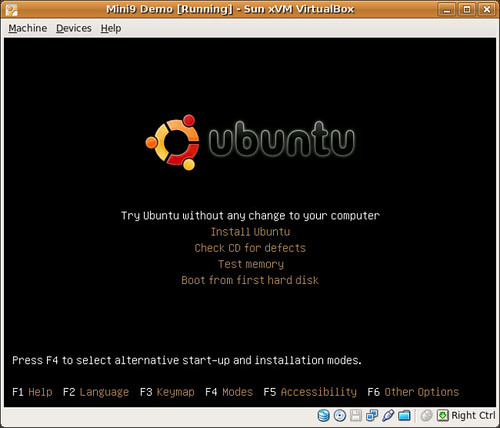
Allow Ubuntu to load, this may take some time.

I choose to try Ubuntu first, after you have made up your mind click the install icon to begin

At the Welcome screen select your language
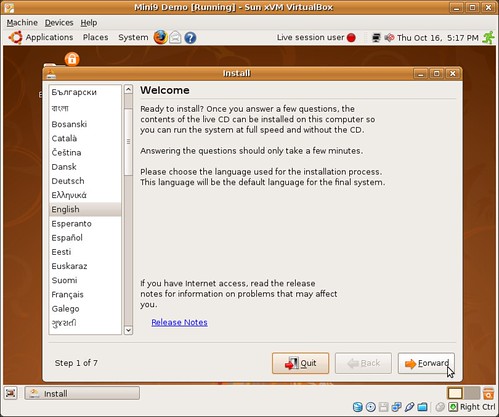
Select your country and time zone
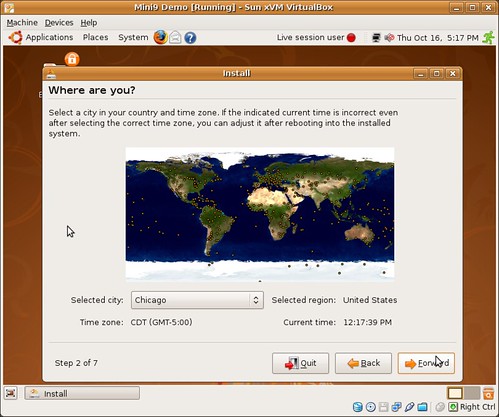
Select your keyboard layout

Now the installer will ask you how you want to partition the disk.
The Guided option will do all the work for you but also install a swap partition. We do not want a swap partition. It will constantly write to your solid state drive, wearing down it's life span.
Select manual. This guide will walk you through two different options for a manual install.
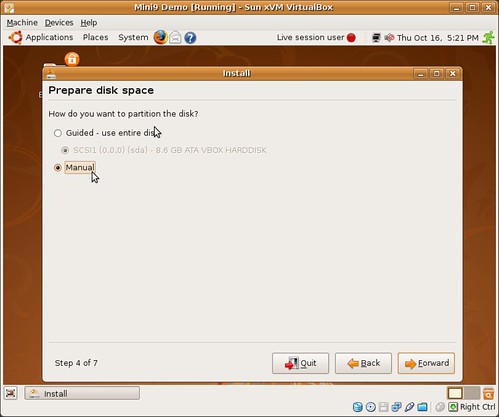
Delete Dell's installed partitions, no love lost there.
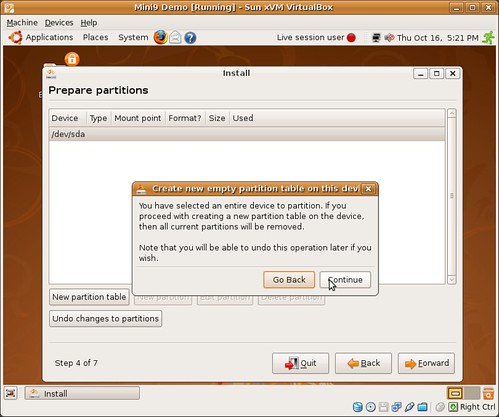
Now you should see your whole hard drive as free space. Select the new partition option.

Method 1: Install your operating system and home folder as two separate partitions.
This is my preferred method, it allows you keep your data and your operating system separate. When you want to upgrade your Ubuntu install, you don't have to worry about losing or backing up your person data (it's separate). When your operating system gets corrupted you don't lose you data.
Now you have to decide on how much space you want to dedicate to your operating system. I chose to use 4GB (1024x4=4096), you need at least 2GB. Make it primary, have it start from the begining, I choose the ext2 file system because it writes less to the disk (you can choose which every you prefer), and it's mount point should be /.

Next, format the remaining space for your home partition (where your personal files and data are stored).
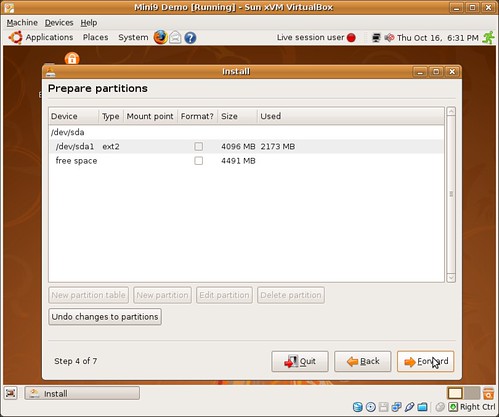
Select Primary, dedicate all the remaining space to the partition, location should be Beginning, File System is your preference and the mount point should be /home.
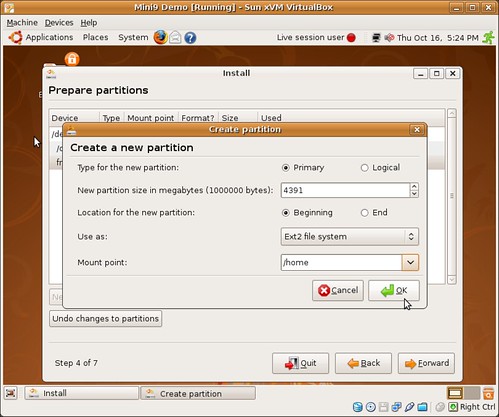
It's normal to end up with some remaining free space. The remaining shouldn't be very large. I ended up with 98MB every time no matter what method I used.
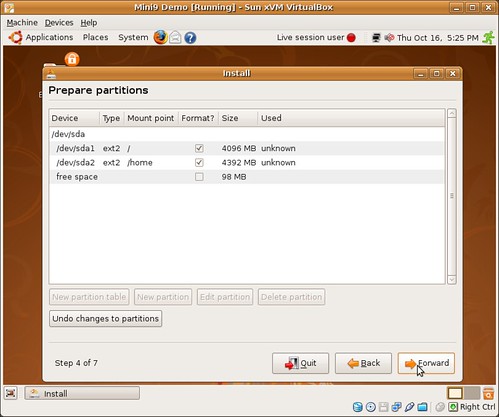
Method 2: Install your operating system and home folder as one partition.
This is not an incorrect way to partition your drive, it's just not my preferred method.

Make this partition Primary and as large as possible. it's location should be beginning, I choose the ext2 file system because it writes less to the disk (you can choose whichever you prefer), and it's mount point should be /.

It's normal to end up with some remaining free space. The remaining shouldn't be very large. I ended up with 98MB every time no matter what method I use.
After continuing forward you will receive this message:
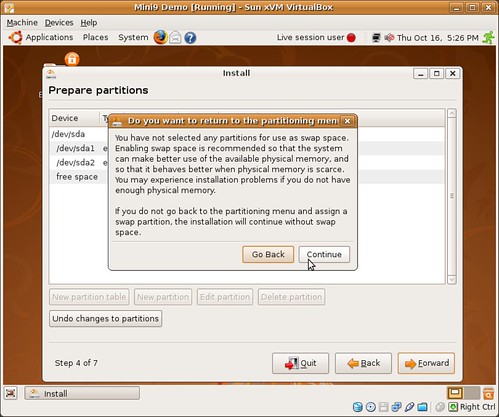
Continue, we don't want swap space.
Setup your user account

Check to make sure you did Method 1 correctly.
It should look similar to this, two partitions, no swap.

Check to make sure you did Method 2 correctly.
It should look similar to this, one partition, no swap.

Ubuntu will begin to install your operating system

Restart

Step 4. Get sound working
In a terminal type:
sudo gedit /etc/modprobe.d/alsa-base
At the end of alsa-base file add:
options snd-hda-intel model=dell

*Then save this file.
Reboot your Mini
In a terminal type:
sudo reboot
After logging in, double click the volume icon and turn your speaker volume up.

Optional: Fix your fstab
If you used the LiveUSB install method, you need to fix your fstab file. The guide can be found here.
Optional: Install Ubuntu Netbook Remix
Follow this guide. Remember to install the correct version for your distro.
Enjoy!

106 comments:
What would you say the big advantages are of this setup vs. the default dell ubuntu 8.04 install? Is it any faster? Does this setup take up less HD space? Just curious.
First it takes care of the hard drive problem. The Mini OS version on Ubuntu that comes installed on the laptop only uses four gigs leaving any other hard drive space unusable. There are workarounds but its not the same as properly setting things up. By separating your system and home partitions you make updating distributions faster, safer and easier. You don't run the risk of losing data if your operating system gets messed up. Netbook Remix is much faster then Dell's custom UI. Ubuntu 8.10 offers significant updates to the Linux kernel, the network manager and includes the ability to use tabs in Nautilus. These three are enough to make me want to upgrade. I will be traveling from state to state with this laptop, I want the network manager to work.
Thanks for going to the trouble of organizing these notes and posting them with the screen captures and all. This is great!
2 questions:
- Will all the mini 9's hardware work with this (bluetooth, WiFi, webcam)?
- Is there any way to get the codecs from a regular DELL mini 9 installation into this?
I'm not able to get Ibex installed on my mini. I've tried both the usb-creator and the UNetBootin utilities and both give me the Ubuntu splash screen, but then kick me into a BusyBox prompt soon after I select the install option. I know my iso is valid as I've used it for at least two VMs. I can use either method to get into a Hardy install though...really strange. A stock 8.04 install doesn't give me wifi, did you pull them from the broadcom site?
Garren,
Both me, pHreak and my buddy Muki have run into these problems on different machines with Ubunutu 8.10 Beta. None of us could figure it out. I think its Intrepid bug.
To get wifi working with 8.04 update your system. wifi will kick in when you get the newest kernel updates.
I think you're right about the Intrepid bug. BUT, the "manual" method in this article works like a charm. It might be worth referencing. Incidentally, your site kicks ass. It crazy to see people getting into the mini as much as they are.
Oops. Forgot the link:
http://www.pendrivelinux.com/2008/10/15/ubuntu-810-persistent-flash-drive-install-from-live-cd/
You don't need any of the unsupported medibuntu stuff if you had a Dell+Ubuntu Mini. Just call support to get LinDVD + legal codecs back again.
Magicfab, good call. Do you know if this actually works?
What a nice step by step instruction here! Thx for the good work, man. Still waiting for my Mini here in Germany, ESD 10/29...
Thanks to your work a well-prepared Ubuntu-Install-USB pen drive is allready waiting here to get things done :)
Great Job - thanks a lot Red!
Thanks, you solved my sound problem I was having booting to an external USB drive with Kubuntu. The "Step 4 Get Sound Working" was the missing piece I needed.
Hi. I just installed intrepid rc 1. But I have major problems with the network card.
The driver r8169 doesn't really seem to work. I have regular breakdowns while using it. It simply stops working until after some seconds it automatically reconnects leaving every previous network connections broken. Did you have any problems like this one?
Noc,
No issues on my end? anyone else
I followed your methodology to install Intrepid Ibex on my Dell Mini 9. Unfortunately I get static / white noise from the speakers.
Has anyone else had this problem and fixed it?
techxplorer, have you checked alsamixer Mic Boost level? I get the same noise if the level is > 50%.
TJ
Fantastic was up all night trying to get sound working
then I found your sight--thank you thank you
one glitch I mistaken myself was the reboot after the first terminal commands, I got confused and did not relize that you meant 1 reboot machine 2 then reboot sudo It got me a bit confused. Hay my mini is singing somemusic and I'm on to thefollowing stages to install remix
Thanks for the info re installation of
Ubuntu on the Mini 9.
I had installed 8.04 via live USB,
partitioning the 16g into equal halves.
(My Mini came with XP)
After getting upgrades everything worked.
I then used upgrade to move to 8.10.
Problems: no wifi. verrrry slow startup. Sound missing.
Is wifi still a problem with 8.10? Fixes?
Thanks.
mikecski,
upgrading does come with problems. I always recommend a fresh install. some people will never have problems and some people wont have sound, wifi, etc.
@TJ,
Yep that was indeed the problem. The Mic Boost appears to have been too high.
Now all I have to do is figure out a way of testing the on board mic.
So many things to do, so little time to devote to my mini
Awesome guide! Out of the box Ubuntu 8.10 worked flawlessly (besides sound and cam).
The tip to enable sound was excellent and worked perfectly on first attempt. You guys rock!!!
i just installed 8.10 on my mini but when i try to get the sound working, i followed the steps of putting that line in the terminal, but when it brings up the file, it is all blank with nothing in it =/ any suggestions???
Anonymous
Make sure you are typing the command right. That file should not be blank.
@techxplorer
I'm not sure I remember correctly, but...
check Volume Control Preferences (Applications, Sound and Video, Volume Control). check Internal Mic Boost box, while in Device HDA Intel (Alsa Mixer). And crank 'er up!
I think that's how I got it working for Skype.
Regards.
How did you guys get the windows key mapped back to F11 for ff and such?
phillip,
we didnt
@ TJ,
Thanks for the hint, I'll try it when I get around to doing the testing.
One thing to keep in mind though is that on my unit if the mic boost is set too high, I get noise coming from the speakers.
I have the same problem with the Win Key behavior of FF. With the Dell Image the Super Key (Windows Key) went fullscreen like with F11.
Now it's just maximizing the FF window.
I wonder if you used standard i386 or Atom-optimized LPIA build of Ubuntu 8.10?
LPIA build available here http://cdimage.ubuntu.com/ports/releases/intrepid/release/
D'oh! I wish I'd known about that before I installed the x86 version. I wonder if I can "upgrade" to it... ?
I know less than nothing about Linux, but while trying to install the lpia build,I get "no common cd-rom found". I tried to mount sda1 as cdrom via the virtual console, but I can't get it to work. I'm going to try the 8.10 Intrepid build as suggested and see what happens.
Anon,
If you don't know Linux then don't waste your time on lpia. i366 the regular version of Ubuntu is easy to install and works better for a beginer. You won't notice a difference because there is no real difference.
mmm i can't not make one image in my pendrive with usb-creator it stops hours in starting up. Seems to be one recognized bug in intrepid (yes another more):
https://bugs.launchpad.net/ubuntu/+source/usb-creator/+bug/295212
I have tried unetbootin but it says in the installation that do not recognize my CD-ROM ?? :(
Another way to install Ubuntu. I really want to delete this disgusting "ubuntu made in dell"...
guta,
I am not trying to be a jerk, but I, as well as, many others have used Ubuntu 8.10 to make a LiveUSB and install it onto my mini. It might be a user or equipment error.
You have to describe the problem better, what kind/size drive are you using and what iso of Ubuntu.
Others have reported that certain USB sticks have just not worked for them. Also what version on Ubuntu are your trying to put on the drive. is it the standard Ubuntu 8.10 i386 iso or the alternative install iso?
This is what i did.
My usb disk was in vfat (1Gb).
I formated it in ext3:
- umount /media/disk
- sudo mkfs.ext3 /dev/sdb
and now when i start usb-creator it tell me to format the disk (yes, again)...
and it works.
Now i can install Ubuntu netboot!
Great guide, thanks!
One problem, I'm using it as a video player for flights but I notice all the videos seem to tear, thought it was a player issue so tried VLC, same.
Looks like the desktop just isn't vsyncing with the screen by default.
Any ideas how to fix this? Thanks
Re the modprobe error. I got the same problem when accidentally trying to install 8.04 desktop ie I chose the wrong image.
Also formatting and reformatting the USB drive may have helped.
Nocturne
Re the r8169 ethernet errors. Known issue with Intrepid driver. Check this link with the details. https://bugs.launchpad.net/ubuntu/+source/linux/+bug/256331.
I downloaded the patched driver from there and all is good. Looks like it will be in the next kernel update too.
Cheers
Excellent guide, thank you very much. Was great help.
When you don't have a swap partition, hibernate doesn't work and if you don't have enough ram for what your doing your computer slows down significantly. I've had both 1GB and now 2GB of RAM in my mini, and never had a swap partition. I never noticed major slow down.
I installed Ubuntu 8.10 but still cannot get the audio to work. Any thoughts?
Thanks
- been reading your blogs since the bad old days . . .
Thanks for a Great step by step guide! I have a couple of rather simple questions. I got everything to work by following your guide, then I was prompted to download/install about 200mb of updates a few of which had to do with the kernel. After I did these install, some of which failed, and restarted the system I had no more wifi. I didn't enjoy that experience so I am re-installing 8.10 at the moment because troubleshooting of the problem was taking too long. Has anyone had problems after installing updates?
2nd question - I read above that without a swap partition there is no hybernate, how about suspend? Can the system not suspend? Closing it doesn't seem to do the trick. Also - mapping for the Fn + 2 key (Wireless on/off toggle), is that an additional application?
Thanks again!
Luobotou,
Go the volume panel and turn the master and speaker all the way up. That should do the trick.
Rundy,
I've burned through a couple of installs on my mini and have never had a problem with the updates and wifi.
Suspend does work and you can configure it trigger when you close the lid.
Mapping wifi on/off is a separate application. There is no deb for 8.10 and I haven't tried installing the tarball.
Hi, thank you such much for your tutorial!
I just installed Intrepid on my Mini 9 with your help but I am having an issue with wireless.
I enabled the Broadcom STA wireless driver and installed the aircraft manager, but it doesn't seem to work.
When I type
"iwlist eth1 scan" I get "Interface doesn't support scanning" although Network Manager is showing me some networks.
Cheking wireless in Aircraft Manager doesn't change anything.
I also cannot connect to my home wireless network (wep protected). Network Manager just keep asking me for the pass...
Hi,
great guide!
just a question... i will be ordering a mini xp with the 16gb ssd. i can still follow this guide i'm assuming if i want to dual boot and allocate say 6gb for ubuntu? where can i configure it? thanks in advance,
andrew.
at the partitioning part. You can use the gui to move a slider to partition the hard drive.
followed this guide all the way a couple of days ago, and everything has been great and all hardware working until a lockup followed by ugly shutdown...lost wifi capabilities...no longer have eth1 network device...lan/network related options still enabled in bios...tried reloading broadcom restricted drivers to no avail....advice?
First of all, thanks to everyone involved with this blog. It's been an incredible resource. I'm in no way a linux newbie, but it's nice to see something you know is 100% relevant to your particular device. I just wanted to post a little note in the rare case someone might find it useful.
I updated my mini 9 with the Super Ubuntu 2008.11 iso. I only chose to use that one because this isn't my first linux rodeo, but it is my first time on the mini 9. Using these instructions of course worked flawlessly. After following the directions to get the sound going, I ran into one hiccup: skype. The audio in or out didn't work. To fix it I had to go to Skype Options->Sound Devices and be sure to choose HDA Intel (hw:Intel,0) for Sound In, Sound Out, and Ringing.
Hope somebody who is needing this information is able to find it here.
Thanks for everything guys.
hope someone can help!
i made a usb live stick on my dell mini with ubuntu as per instructions - http://www.ubuntumini.com/2008/10/make-liveusb.html
i installed a runcore 64g ssd as per the video at: http://www.youtube.com/watch?v=vnwl0RVsjIE&eurl=http://cgi.ebay.com/RUNCORE-64GB-MINI-PCI-e-PCIE-DELL-INSPIRON-MINI-9-SSD_W0QQitemZ120354762303QQihZ002QQcategoryZ31567QQcmdZV
i restarted the dell mini and pressed the 2 key to go to bios and navigated to the boot menu. i made usb storage the topmost option in that menu (so it would boot first). i saved settings (F10) and and the mini restarted automatically - and immediately said:
Ntldr Is Missing
and gave the option to restart with Control-alt-delete.
i've tried every configuration possible in the boot part of the bios and the mini still won't restart. more troubling is i reinstalled the original 8g drive that came with the mini and it still won't restart; it says os not found. in both cases, the mini appears to see the 8g and the 64g drives .... at least it says it does in the boot part of the bios.
all help much appreciated. thanks in advance!
ok .... have moved past the disaster just described. now installation freezes at step 4 (of7) ... on a prepare partition screen. i'm installing (am trying to install) from a san cruzer usb drive.
9 out of 10 problems with using the LiveUSB method is your USB stick. Some sticks work and some don't. If you are having problems, it is most likely your USB stick.
wish I would have found this guide before I did it myself. The factory installed 8.04 wouldn't upgrade to 8.10 so I got upset and just put vanilla 8.10 on it.
ok. thanks. all now works and the directions you've posted are excellent and really, really helpful. all the error messages that appeared were a result of (1) an incorrect choice i made when setting BIOS and (2) results of the runcore (which now appears to be fantastic) rather than the dell drive. which is all to say if choice a doesn't work, try choice b :)
thanks very much for taking the time to post so many helpful how-tos.
Hi there !
I've got a question about the battery-life with the "normal" 8.10 version on this dell mini.. when you habe 8.10 on it, it isn't a lpia kernel, so it has to need more energy ?! Does this affect on the battery-life ?! I've got about 4hrs, with the dell installation of 8.04, but i'm thinking about makinig 8.10 on it..
what would you prefer ?! isnt this "netbook remix" a energy-effecient version ?!
Anyone know how to get the 3G mobile broadband slot working on Ubuntu?
Thank you very much for your informative article. I have it bookmarked!
It worked perfectly. Thank you =)
I get a message saying "invalid or damaged bootable partition" when i try to boot from a live usb. any suggestions on how to fix this?
Mig
It's probably your thumb drive
thanks red. it worked after i used gparted to create a 1gb boot partition on my kingston 4gb stick. i'm not sure why this is, but it may be worth noting somewhere. also, is it a good idea to create a /usr partition? i'm thinking 4gb root, 4gb /usr, and the rest for /home on the 32gb ssd.
awesome blog btw. the tutorials are much appreciated.
Ok ok... check this out. Maybe you guys can help me here. I installed 8.10 just fine, and most things worked right away, except the sound, but that is expected. Now here's the problem; I did the "trick" to fix the sound, and it did not work! I had to reinstall 8.04 for now... any ideas?
Crash,
Fixing the sound is not a trick. You are enabling sound by adding a line of code. It is not working because you did not do it right. If you want to enable sound follow the directions and remember to turn up the speakers.
@redDEAD
Thx for the quick reply. I'm sure I'm doing it right... and my speakers are up. any ideas? :(
Crash,
Thats the fix. It works, thousands have enabled sound this way. Either you are not doing it correctly or you do not have your speakers selected and turned up in the volume manager.
I used Method 1 for my filesystem (home partition and OS partition) but I am confused as to if I did it right. My OS partition (just the /) was made to be around 4gb (3.8 to be exact) and I have used 3.4 of that. My home is 10.4gb and I have only used 105 mb. I have downloaded many programs - do those go into my home partition or just the OS? I install most programs through the Add/Remove app. It seems like I should have a lot more free space on my OS partition and a lot more used on my home, but maybe I'm wrong. I also am not sure where to look for these installed programs. Yes, I am a huge Linux noob.
Thanks!
The go onto your root partition (the /) not your /home.
Ubuntu will "look" like it is eating up a lot of room, no worries mine looks the same way.
Unless you downloaded KDE4, xfce, and a bunch of other window managers you should be aright. Most programs in add/remove are small.
I installed 8.10. Great instructions. Everything is OK except I have no WiFi. Reading the comments, others have mentioned this problem but I find no specific answer. Should I reinstall from the usb drive or is there a better solution? When I click the icon, I get "The network has been disconnected." Advance thanks from this nubie.
It's not your mini it's your connection. If you have encryption or a hidden network it takes a little more effort.
Waiting on my Mini 9 to arrive and it will be my first experience with Linux (lifelong Mac user.) Considering purchasing one of those "live USB's" loaded with 8.10 off of ebay and am curious if anyone has done so and can confirm that a particular brand etc. works on the mini 9. My understanding is that not all thumb drives are created equal in this respect.
Thanks!
Thanks for the guide. I just got my Mini9 with XP and wanted to try it out with Linux. I followed your guide - but actually installed Linux Mint 6 (Felicia) and worked a charm. Audio now working and about to install Amarok and try UNR. Cheers
After reading the below article about SSD endurance, I'm inclined to go ahead and use ext3 and swap. Additionally, I'll probably upgrade to a larger SSD in 2-3 years anyway.
http://www.storagesearch.com/ssdmyths-endurance.html
True Randy, SSD are pretty tuff and in 2 years an 8GB drive will be 25 bucks.
Awesome blog!
So when my Mini came in, I realized I mistakenly only ordered a 4 gig HD. Am I going to have enough room to install Intrepid, with Netbook remix, skype, and every thing else to let me watch every type of video dvd or internet? And still have room for other files?
Will I be able to utilize an SD card to help with extra storage space? Or should I be looking at going with a lighter distro (like Xubuntu). At least until I can upgrade my HD to at least 8 gigs.
Maybe you can give some recommendations how I might best set up my installation.
The mini like i said has a 4 GB ssd, and 2 GB memory. With the 1.3Mp Webcam.
warriorx808
Buy a bigger HD
First off, thank you for making this site and maintaining it. Like someone before me said, it is reassuring knowing that there is a site specifically devoted to my product and setup.
That said, after reading some of these comments, can I make a suggestion? I think you should devote a page to USB stick brands that are known to work as Live sticks. Readers can leave in the comments a particular brand and size they used that worked successfully, and also maybe list those known to cause problems. Just a thought.
Keep up the great work!
Hello - Awesome tutorial! I was able to get everything working except for the sound part. Part 4 did not do the trick for me. Any ideas?
N74JW
I'm not trying to be mean but you didnt do it correctly. Redo the steps. you might have typed the code in wrong or not saved.
Make sure you turn up the volume.
redDEAD,
I appreciate any help, that anyone can offer, but I must disagree. I copied/pasted the text. Even I can't screw that up. I posted my alsa-base file in a support thread at:
http://ubuntuforums.org/showthread.php?p=6842861#post6842861
I am not surprised, Linux and I just don't jive. I could have Vista installed and running on this thing in 30min, but who wants Vista?
I wound up having to rebuild the ALSA modules, but now I have sound...
I got my Mini 9 a few days ago and automatically installed Ibex because the preinstalled version did not support my Bluetooth keyboard and also because I've been using Ibex on my regular laptop. Of course there was no sound. I followed the instructions on this page and voila! Thanks.
redDEAD said...
True Randy, SSD are pretty tuff and in 2 years an 8GB drive will be 25 bucks.
you can get a 16gig ssd for like 35
http://www.newegg.com/Product/Product.aspx?Item=N82E16820609350
In regards to the sound fix. I think the people that are having trouble are forgetting to save the file after adding the line of code. The tutorial does not say to save the file before restarting the machine.
repustech
I think your right, I guess you can never assume.
Great guide.
I previously tried to install CentOS 5.2 to my Mini, but it paniced during the earliest stages of bootstrapping itself.
I installed a liveUSB 8.10 built under Windows, using an 8GB Sandisk Cruzer Micro. The build has a 2.6.27-7-generic kernel. Ethernet, wireless and fstab work, but sound still needs the fix. I don't have any Bluetooth peripherals, so I can't test that.
I snuck in a step for fdisk as given here:
http://thunk.org/tytso/blog/2009/02/20/aligning-filesystems-to-an-ssds-erase-block-size/
The filesystem now is aligned to the cylinders, but I don't know if there is any performance gain.
Great tutorial! I, too, tried your way to get sound to work but still nothing. Could it be BIOS A4 that's causing no sound? I retried it, tried capitalizing "Dell" etc., etc. I added your line to the end with the "D" in "Dell" capitalized (in addition to the line you suggest and got some "noise" from Rythmbox radio but no sound. Any ideas?
Oh, and two other questions... is there a way to disable pasword upon resume from suspend and is there a way to disable need for a password on the wifi network keyring? Thanks in advance.
Just got my mini 9 yesterday & wanted to give you a huge thanks for this blog... it is indispensable.
Great guide -- thanks very much. Going to try this tonight!
Couldnt get the sound working after installing Kubuntu8.10 and after following your guide, it does now.
Thanks.
Got a Mini 9 new from Dell 2 days ago w/ 8.04. Found my system always (100%) crashed attempting to connect to a WPA2-protected network. Have seen bugs reported on launchpad reporting same problem, and tried some of the workarounds suggested there (feisty_no-fluff, disabling bluetooth) without success.
So - tried running 8.10 from USB as described above. Very stable except encountered same problem attempting to connect to WPA2 network - locked up OS.
Anyone having same issues? Fixes? Thanks
has anyone tried this with the 12? just wondering if it works?
@Bob
That SDD isn't for the 9. You have to look for a half mini PCIe card.
such as http://www.newegg.com/Product/Product.aspx?Item=N82E16820609413
45 bucks.
I just ordered my Mini 9 yesterday, with 2 Gig of RAM and 32 GB SSD. It should be arriving just about the same time as Ubuntu 9.04 comes out. I've been using Ubuntu since 7.04 on my desktop and loving every second of it, but this will be the first time I've used it on a laptop.
This tutorial and this website in general are awesome, so thank you very much! I'll probably wait until 9.04 to wipe away Dell's factory-installed Ubuntu, so I know some version-specific instructions may change.
I have one generic question, though. Given the mobile nature of the Mini 9, I'll be taking it around with me alot. However, I won't want to completely shut down each time. I know suspend will probably work right out of the box, but without a swap partition, hibernation will not work. Is there a specific reason that you don't think hibernation is useful for your preferred setup? Also, how large do you think I should make my swap partition to be able to hibernate?
I have the 32gb HD, I gave myself 4gb for the root partition like you recommended, and left the rest for the home partition. The installation went flawlessly, installed Netbook remix the next day, also went fine. I went into the Synaptic Package Manager to download some games, and halfway through the download sequence, the remaining packages all failed. I gave up on it for now, and noticed I had 200-something updates to apply for my update manager, and when I tried to do that, they failed too. I'm not an expert with Ubuntu but it appears that it ran out of space, and its apparently because everything I set up to download got stuffed into that root partition and while my home partition is relatively empty, my root partition is at almost 100% capacity. What did I do wrong? Was there some step I was supposed to take to clarify where to download these updates, games, etc to? Thanks so much for anyone who can help.
Sean that was recommended for 8 and 16GB HDs. I'd give it more if I had an 32GB HD.
If you ran out of room just reinstall and make it bigger.
I don't have games installed except the default on my desktop and mini and am barely at 2.9GB for my /root partition.
It might be the games you tired downloading eating up HD space.
Good job ordering your Mini9 -- it's about to be discontinued at the end of April. A new version of the Mini10 (internal Dell code name: Bear) will replace it, with the N270 proc.
Late May Bear will be updated with the N280 proc and GN40 chipset, and then around September everything will be updated with Intel Pineview.
Anyway, the bottom line is, if you want a Mini9, get it now. I'm ordering mine tomorrow :D
(BTW, Matt_H, in answer to your question, I don't think suspend works properly out of the box. It works most of the time on my friend's mini, but sometimes it doesn't resume)
Thank you for the post.
I ve installed 8.10 on my ubuntu with 4gb ssd.
Which drivers do I have to install?
Drivers from the cd that came with dell or drivers for ubuntu are different??
I want to install as few as possible because of ssd. Which ones do you prefer.(ım using it for only internet and it connects know perfect)
Also when i plug internet with cable it doesnt connect.(wireless is okey)Do you have a suggestion??
That disk is for Window Drivers not Ubuntu Drivers. In Ubuntu the drivers are built into the kernel, you do not need to install them after installation of the operating system.
I've just bought the Mini 12, and I love the thing to death, but the built in Dell version of Ubuntu? Yea, not so much. I'm going to try out your method, thought I'm sort of afraid...
Apart from the sound, everything should work the same, right? (Webcam, wireless, etc.)
I don't want to end up killing the computer before I've actually lived with it.
The Dell OS is sooooo sloooooow thooooough...
How would I know, I only have a mini 9.
i put 9.04 desktop edition on my 9" dell mini with 4GB SSD and it works great with all the drivers from the install. I installed using a live usb stick.
Dear all, Just continued Comment =
"Graham said...
Anyone know how to get the 3G mobile broadband slot working on Ubuntu?
January 13, 2009 5:58 AM "
Please Anyone can assist?
Where can I download the driver for Broadband Dell 5530
(It's my problem too). Thanks
I turned my mini on one day and when starting my PC told me it couldnt find the operating system so I decided to install ubuntu as I dont have an external CDROM to do Windows.
After trying both methods listed here to the letter, I still get an error stating:
"The ext2 file system creation in partition # 1 os SCS1 (0,0,0) (sda) failed."
Is something wrong with the HDD? When I try to double click on the drive in 'Computer' Im told its unable to mount location, however in BIOS it tells me I have a 15408MB HDD so it still seems to be showing up.
Any help would be HUGELY appreciated, thank you in advance.
Your hard drive is damaged, contact dell for a replacement if you are under warranty. If not be prepared to buy a new one.
Since you dont own a mini 9, and didnt say what kind of mini you own, I cant help you with which model to buy.
red i just finished a fresh install of 9.10 and i set it up using the two partition option youve shown. now the only problem is i cant copy/paste to the /home. any help would be appreciated.
Had anybody found the Driver for Wireless Modem HSPA with slop simCard in Dell Mini 9?.
Please share..
Thanks
i have a mini 10 i am looking to use primarily for streaming music to my home audio system. can anyone let me know how the support for the Dell builtin wireless and sound are under Ubuntu 9.10? From what I have read it should not be hard to get either working...Thanks.
Post a Comment